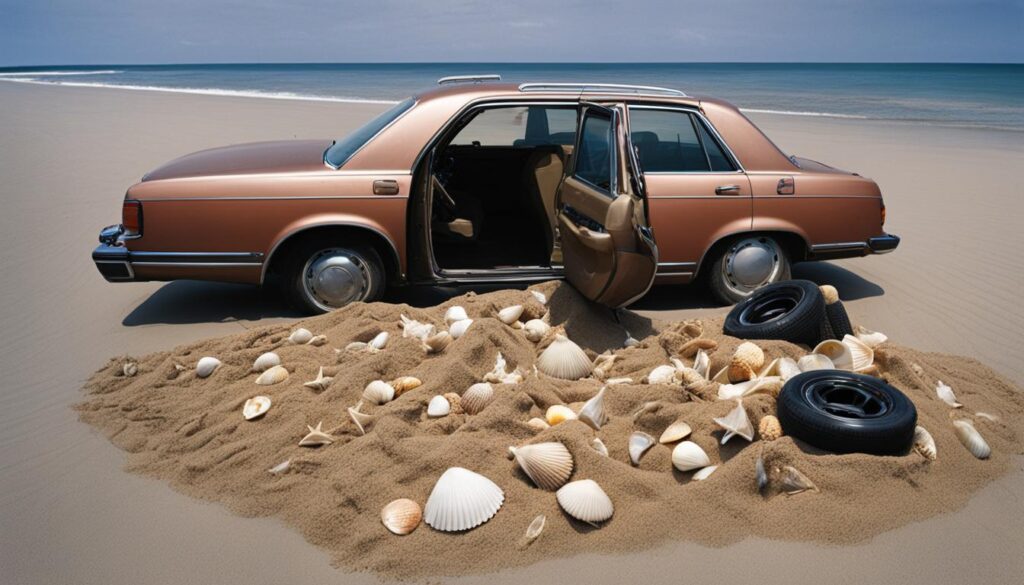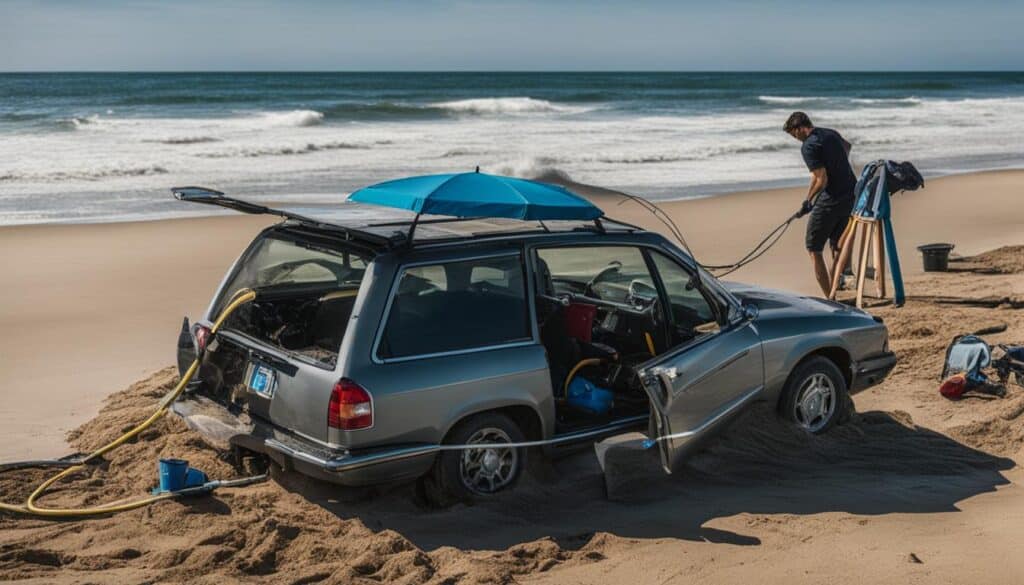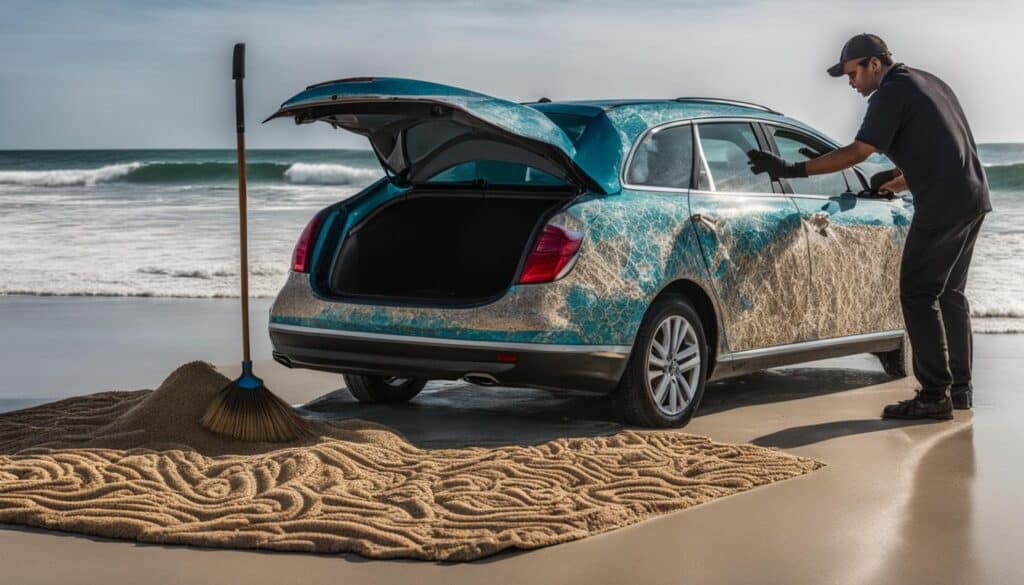As a car owner in New Zealand, beach trips are undoubtedly a part of your summer routine. However, it’s important to take precautions to protect your vehicle from the damaging effects of sand and salt. The combination of abrasive sand particles and corrosive saltwater can wreak havoc on your car’s exterior and interior. But fear not, with these simple but smart tips, you can ensure your car remains beach-ready while maintaining its value and appearance.
Key Takeaways:
- Protecting your car from sand and salt at New Zealand beaches is essential for maintaining its value and appearance.
- Choose calm water for your last swim to minimize sand in your car.
- Use mesh bags to prevent sand accumulation in your vehicle.
- Opt for all-weather floor mats to quarantine sand.
- Wear thongs or open-toed shoes to prevent sand transfer from footwear to your car.
Preparing for the Beach: Smart Strategies
Before hitting the beach, there are several strategies you can employ to protect your car. By taking these precautions, you can ensure your vehicle remains in top condition, free from the damaging effects of sand and salt. Here are some smart strategies to consider:
- Choose calm water for your last swim: When planning your beach day, opt for areas with calm water to minimize the amount of sand that sticks to your body. This can significantly reduce the chances of transferring sand to your car’s interior.
- Use mesh bags to prevent sand accumulation: Bring mesh bags and place your sandy belongings in them. The mesh allows the sand to fall through, keeping it contained and preventing it from spreading throughout your car.
- Opt for all-weather floor mats: Invest in high-quality all-weather floor mats that can withstand sand, salt, and water. These mats are designed to trap and quarantine small particles, making them easy to clean and preventing them from causing damage to your car’s interior.
- Sit on chairs instead of beach towels: When relaxing on the beach, consider using beach chairs instead of sitting directly on beach towels. This can help minimize the amount of sand that sticks to your body, reducing the chances of transferring it to your car.
- Line your car’s cargo area: You can protect the cargo area of your car by lining it with a plastic sheet or a mat. This will create a barrier between your belongings and the sand, allowing for easy cleanup and preventing potential damage to your car.
Implementing these simple strategies can go a long way in protecting your car from the sand and salt commonly found at the beach. By taking these preventative measures, you can enjoy your beach trips without worrying about damaging your vehicle.
Wearing the Right Footwear
When it comes to protecting your car’s interior from sand particles, the type of footwear you choose can make a big difference. Closed-toe shoes are notorious for gathering sand, which can easily find its way into your vehicle’s upholstery. To prevent this, it is best to opt for beach-friendly footwear such as thongs or open-toed shoes. Not only will these keep your feet comfortable on the sandy shores, but they will also minimize the risk of transferring sand into your car.
Wearing thongs or open-toed shoes serves as a simple yet effective barrier against sand particles. With each step, you can easily shake off any sand that might otherwise cling to your footwear. By doing so, you significantly reduce the chances of tracking sand into your car and ensure a clean and beach-friendly environment.

To protect your car’s interior from sand, it’s important to consider every possible entry point for those stubborn particles. Closed-toe shoes can capture sand between their sole and your feet, acting as tiny sand traps. The sand can then easily transfer into your car as you enter or exit. However, by simply changing your footwear to beach-friendly options, you can minimize this risk and enjoy a sand-free journey.
Cleaning Techniques for After the Beach
After a day at the beach, it’s crucial to clean your car properly to remove any sand or salt particles. Failure to do so can lead to paint damage, corrosion, and a less-than-pristine ride. Here are some effective cleaning techniques to help you maintain your car’s appearance and protect it from the damaging effects of sand and salt.
Rinse off the Sand and Salt
Start by thoroughly rinsing your car with water to remove the majority of the sand and salt. Use a hose or pressure washer to reach all the nooks and crannies. Be sure to focus on the wheel wells, undercarriage, and any other areas where sand and salt tend to accumulate.
Gentle Cleaning with a Sponge or Quality Car Cleaner
Once the initial rinse is complete, use a clean sponge or a high-quality car cleaner to further clean your car’s exterior. Avoid using abrasive materials that could scratch the paintwork. Instead, opt for soft cloths or microfiber towels.
My go-to car cleaner is [BRAND NAME]. Its gentle formula effectively removes dirt while being safe for all types of car paint.
Don’t Overlook the Interior
Sand has a sneaky way of finding its way into every nook and cranny of your car’s interior. Shake out any beach towels or blankets before entering the vehicle to remove excess sand and dust particles. Vacuum the seats, floor mats, and carpet thoroughly using a handheld vacuum or a car-specific vacuum cleaner.
Protective Wax or Sealant
Consider applying a protective wax or sealant to your car’s exterior after cleaning. This will provide an extra layer of protection against sand, salt, and UV rays. Be sure to follow the manufacturer’s instructions for application and reapplication frequency.
The Final Touch: Clean the Windows and Mirrors
Don’t forget to clean the windows and mirrors to ensure clear visibility. Use a glass cleaner and lint-free cloth or newspaper for streak-free results. Pay attention to any residue left behind by saltwater, as it can affect visibility and compromise safety.
Top Cleaning Techniques for After the Beach
| Technique | Description |
|---|---|
| Rinse Off | Thoroughly rinse the car with water to remove sand and salt. |
| Gentle Cleaning | Use a sponge or quality car cleaner to clean the exterior without scratching the paintwork. |
| Interior Cleanup | Shake out beach towels, vacuum seats and floor mats to remove sand and dust. |
| Protective Wax or Sealant | Apply a protective wax or sealant to shield against sand, salt, and UV rays. |
| Clean Windows and Mirrors | Use a glass cleaner and lint-free cloth for streak-free visibility. |
By following these cleaning techniques, you can ensure your car remains free from sand and salt particles, preserving its appearance and protecting it from potential damage. Remember, regular care and maintenance are essential for extending the lifespan of your beloved ride.
Using Seat Covers and Sheets
When it comes to beach trips, protecting your car seats from dirt, spills, and sand is essential. Seat covers can provide an extra layer of defense, preserving the original upholstery. They act as a barrier, preventing any potential damage caused by beach debris or wet bathing suits. Investing in seat covers is one of the top car protection options for beach trips, ensuring the longevity and cleanliness of your car’s interior.
If you don’t have seat covers, don’t worry! There’s a cost-effective alternative that can still offer some level of car care for beach conditions. Simply double over a sheet and place it on the back seats. While it may not provide the same level of protection as seat covers, it can help shield your seats from dirt and sand. However, it’s important to note that small children can easily displace the sheet, causing a mess on the seats.
With the use of seat covers or sheets, you can keep your car’s seats in pristine condition, free from the damaging effects of beach elements. Whether you opt for seat covers or a sheet, it’s an excellent way to prioritize the best car care for beach conditions, allowing you to enjoy your beach trips worry-free.
Low-Tech Cleaning Tips
When it comes to protecting your car from the harsh ocean elements and maintaining its pristine appearance, even the simplest cleaning methods can go a long way. Here are a few low-tech tips that can help you keep your car sand-free and beach ready:
1. Cleaning Sandy Carpet Car Mats
If your car’s carpet mats have become filled with sand, there’s a simple trick to remove those pesky particles embedded in the fibers. First, remove the mats from your car and shake them vigorously outside to dislodge as much sand as possible. Next, clap the mats together to loosen and dislodge any remaining sand. Finally, use a vacuum cleaner to suction away the loose sand, leaving your mats clean and sand-free.
2. Removing Sand from Clothes and Shoes
After a day at the beach, it’s common for sand to stick to your clothes and shoes. To prevent sand from finding its way into your car, remove as much sand as possible before getting in. Stand in an open area and clap your feet together, shaking out any sand trapped in your shoes. Additionally, give your clothes a good shake to remove any remaining sand particles. This small effort can make a big difference in keeping your car’s interior sand-free.
3. Taking a Post-Beach Shower
Taking a quick shower after a day at the beach can provide multiple benefits for both you and your car. Not only will it help you feel refreshed and remove any lingering sand from your body, but it will also prevent sand particles from transferring onto your car’s seats or surfaces. So, before getting into your car, take a few minutes to wash off any sand, ensuring that your car remains clean and protected.

4. The Benefits of Low-Tech Cleaning
“Even though low-tech cleaning methods may seem simple, they are highly effective in maintaining your car’s cleanliness and protecting it from beach elements,” says James Peterson, a renowned car detailing specialist. “By incorporating these low-cost techniques into your routine, you can extend the life of your car’s interior and ensure it remains sand-free, no matter how many trips to the beach you take.”
With these low-tech cleaning tips, you can keep your car looking its best despite exposure to the ocean elements. By regularly implementing these simple methods, you’ll not only maintain your car’s appearance but also preserve its value in the long run.
Considering Additional Protection
If you live near the beach or frequently visit coastal areas, taking extra measures to protect your car from sand and salt is crucial. Here are some additional car protection options you may want to consider:
- Use a car cover with a fabric underside to shield your vehicle from the accumulation of sand and salt. This will help prevent filth from resting on your car’s surface, preserving its cleanliness and condition.
- Install a bonnet protector or car bra to protect the front end of your car from damage caused by small particles on the road. These accessories can provide an extra layer of defense against sand, salt, and debris kicked up while driving.
Protecting Your Investment
“Investing in additional car protection measures, such as a car cover or bonnet protector, can provide long-term benefits by preserving the value and appearance of your vehicle. By safeguarding against sand and salt, you’re ensuring that your car remains in top condition, even in beachside environments.” – Car Care Expert
By opting for these extra safeguards, you can enjoy peace of mind knowing that your car is well-protected against the harsh effects of sand and salt.
| Additional Car Protection Measures | Advantages |
|---|---|
| Car cover with fabric underside |
|
| Bonnet protector or car bra |
|
Investing in these additional protective measures can go a long way in maintaining the value and appearance of your car, giving you the confidence to fully enjoy your beach trips without worrying about the damaging effects of sand and salt.
Driving on Sand: Basic Tips
When it comes to beach trips, knowing how to navigate sandy terrains is crucial for both enjoyment and car protection. By employing proper driving techniques, you can minimize the risk of getting stuck in the sand, ensuring a smooth and safe journey. Here are some basic tips to keep in mind:
-
Recognize different surface conditions: Sand can vary in texture and firmness, so it’s important to be aware of the surface you’re driving on. Soft, deep sand requires a different approach than compacted or wet sand.
-
Maintain momentum: Keep a steady speed and avoid sudden stops or jerky movements that can bog down your car. This will help prevent your vehicle from sinking into the sand.
-
Reduce tire pressure: Lowering your tire pressure can improve traction on soft sand. Use a pressure gauge to adjust the tire pressure according to the manufacturer’s recommendations.
Remember, driving on sandy beaches can be challenging, especially for inexperienced drivers. If you’re unsure or uncomfortable, it’s best to seek advice from professionals or local beach authorities to ensure your safety and protect your car from potential damage.
| Tips for Driving on Sand | Beach Car Protection Level |
|---|---|
| Recognize different surface conditions | Low |
| Maintain momentum | Medium |
| Reduce tire pressure | High |
Conclusion
Protecting your car from the sand and salt at New Zealand beaches is crucial to maintaining its value and appearance. By implementing the strategies and cleaning techniques discussed in this article, you can enjoy your beach trips without worrying about damaging your vehicle.
Remember, prevention is key when it comes to beach car protection in NZ. Start by employing smart strategies before hitting the beach, such as choosing calm water for your last swim and using mesh bags to prevent sand accumulation. Additionally, wearing beach-friendly footwear like thongs or open-toed shoes can help keep sand out of your car’s interior.
After your beach adventure, make sure to clean your car properly to remove any sand or salt particles. Rinse your car with water before using a sponge or car cleaner, and shake off any remaining sand and dust. Consider using seat covers or sheets to provide an extra layer of protection for your car’s seats and be cautious with small children to avoid any mess.
If you frequently visit coastal areas, you may want to consider additional protection measures like using a car cover with a fabric underside or installing a bonnet protector. And for beach driving, remember to use proper techniques to minimize the risk of getting stuck in the sand, such as maintaining momentum and reducing tire pressure for better traction.
With these tips in mind, you can confidently enjoy the beautiful beaches of New Zealand without compromising the condition of your car. So go ahead and plan your next beach trip, knowing that you’re well-equipped to protect your vehicle from the elements.
FAQ
How can I protect my car at the beach?
There are several strategies you can employ to protect your car at the beach. These include choosing calm water for your last swim to minimize sand, using mesh bags to prevent sand accumulation, and opting for all-weather floor mats to quarantine sand.
What footwear should I wear at the beach to protect my car’s interior?
To prevent sand from transferring to your car’s interior, it’s best to wear thongs or open-toed shoes when visiting the beach. This will keep your feet comfortable and protect your car’s interior from sand particles.
How should I clean my car after a day at the beach?
To clean your car after a day at the beach, it’s crucial to rinse it with water to remove any sand or salt particles. Then, you can use a sponge or quality car cleaner to avoid scratching the paintwork. Additionally, shaking off any remaining sand and dust particles before entering your vehicle can help keep it clean.
How can I protect my car seats at the beach?
Seat covers can provide an additional layer of protection for your car’s seats, preventing dirt, spills, and sand from damaging the original upholstery. If you don’t have seat covers, using a doubled-over sheet on the back seats can be a cost-effective alternative. Just be cautious with small children, as they can displace the sheet and allow mess onto the seats.
How can I remove sand from my carpet car mats?
If your carpet car mats get sandy, you can use a simple cleaning method to pick up the sand embedded in the carpet fibers. Clap your feet together and shake out your clothes to remove any remaining sand particles. Taking a shower after a day at the beach can also help protect your car from sand on your clothes.
Are there additional measures to protect my car if I live near the beach?
If you live near the beach or frequently visit coastal areas, additional car protection measures can be considered. Using a car cover with a fabric underside can prevent filth from resting on your vehicle, while a bonnet protector or car bra can prevent damage caused by small particles on the road.
What driving techniques can help me minimize the risk of getting stuck in the sand?
To minimize the risk of getting stuck in the sand, it’s important to use proper driving techniques. These include recognizing different surface conditions, maintaining momentum to avoid getting bogged down, and reducing tire pressure for better traction on the sand.
How can I ensure my car stays protected at the beach?
By implementing the aforementioned strategies and cleaning techniques, you can ensure your car stays protected at the beach. These measures will help minimize the damage caused by sand and salt, allowing you to enjoy your beach trips worry-free.




